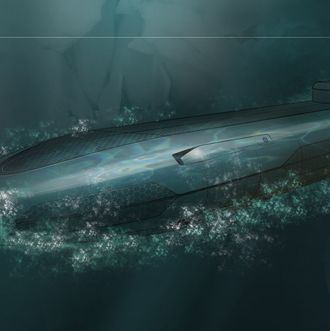
The fastest airplane to ever take flight was the SR-71 spy plane, which was capable of traveling over 2,000 mph. The fastest-ever car was Thrust SSC, which holds the land-speed record of 760 mph. And the fastest submarine was the 51 mph Soviet K-222 nuclear attack sub.
Why is traveling through water such a fundamentally slower process? Obviously, it’s a denser medium, meaning you have to shove more weight out of the way to move forward. The interaction between the fluid and an object’s surface causes a phenomenon called skin-friction drag. The faster you go, the more power you have to expend, at an exponentially increasing rate. That’s just physics. But while Moore’s Law can make microchips twice as powerful every 18 months, cargo ships still cross the ocean at the same speed they did 150 years ago.
Scientists are now working to crack that paradigm wide open. The idea is to use a technique called supercavitation to eliminate much of the drag associated with traveling underwater and thereby achieve startling speeds — even, potentially, breaking the sound barrier.
Regular cavitation occurs when the passage of an object through water creates a low-pressure area that causes bubbles of gaseous water vapor to form. (Think of the jet of white bubbles that shoots out from a motorboat propeller.) Supercavitation involves shrouding a hull in a giant bubble so that the liquid can’t touch the surface and skin friction doesn’t apply. It’s like enjoying the slipperiness of an air-hockey puck, but on all sides. Propulsion is supplied by a rocket engine.

Sounds like a great idea — so why isn’t supercavitation used all over the place? It turns out that racing around inside an underwater bubble poses some technical challenges. One is called pulsation, which occurs when part of the bubble contracts unexpectedly. Scientists at the Applied Research Lab at Penn State are working hard to get out the kinks using a water tunnel — a hydrodynamic version of a wind tunnel — to figure out how to create stable bubbles. Once that gets sorted out, subs could travel at speeds of up to 100 mph, the researchers say.
The U.S. military has long been interested in building a super-speedy submarine. A decade ago, DARPA tinkered with the idea of an experimental supercavitation sub, the Underwater Express, to carry troops underwater at more than 115 mph. But it faced a fundamental problem: Rocketing along inside its bubble, such a vehicle would have no way to steer itself. Now the Chinese are working on a concept that could overcome that hurdle. Scientists at Harbin Institute of Technology’s Complex Flow and Heat Transfer Lab have developed a liquid membrane that could be used to help steer a sub at high speed. This approach could open the door, they say, to a supersonic sub that could cover the 6,000 miles from Shanghai to San Francisco in 100 minutes.
If such a prospect seems a long way off, rest assured that practical supercavitation technology is not pure fantasy. The Russians have had a supercavitating torpedo, the Shkval VA-111, in active service since the 1990s. The 6,000-pound weapon launches from its torpedo tube at more than 50 mph, and once clear of the ship, its rocket fires and propels it at speeds of up to 230 mph. A 330 mph version is said to be in the works. In 2000, alleged U.S. spy Edmond Pope was tried and convicted for trying to steal Shkval secrets (Putin subsequently pardoned him). Germany and Iran have their own supercavitating torpedo models, too.
As far as is known, no such weapons have yet been fired in a conflict. So how well they work — or if they really work at all — is a question that’s yet to be answered.
